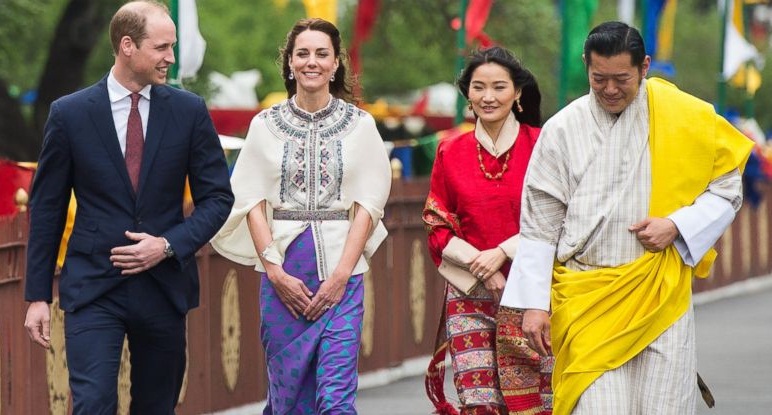History of Bhutan
Our King and Queen with Prince Willam and Kate

People, Government- Food – Electricity – Currency – Language
People: Little over eight hundred thousand people inhabited widely in lower fertile lands in the south to the great Himalayas in the north. Various ethnic groups like Ngalops, Sharchops, Lhotshampas, Bjops, Brokpas & Doyas are inhabitants of Bhutan. People of Bhutan are called drukpas, meaning people living in Druk Yul, land of thunder dragon. Bhutanese are soft spoken, never tired of smiling and generally has shy personality.
Ngalops, Mongoloid origin inhabited most of the western districts of Bhutan and follow Kagyupa form of Buddhism. Sharchops, Indo Mongolian origin inhabited eastern districts. They practice Ningmapa form of Buddhism and are supposed to be the earliest inhabitant of Bhutan. Lhotshampas, Nepalese origin, of Hindu background occupy southern districts. Bjops and Brokpas are found in the extreme north and north eastern region. Doyas live in south west region. There are around 18 dialects spoken by different ethnic groups in Bhutan.
Government : The Government of Bhutan is a constitutional monarchy. Between, 1907 to 1950s Bhutan however was an absolute monarchy. The peaceful march to democracy has been a steady one. The King of Bhutan is head of state. Executive power is exercised by the Lhengye Zhungtshog, or council of ministers, headed by the Prime Minister. Legislative power is vested in the bicameral Parliament, both the upper National Council and the lower National Assembly. In 2008, Bhutan adopted its first modern Constitution, codifying the institutions of government and the legal framework for a democratic multi-party system. King is head of state and Prime Minister is head of the government.
Food : Bhutanese dishes are rich with spicy chillies and cheese, visitors can enjoy the Bhutanese cuisine with less spice if that is your preference. Delicious Indian, Chinese and Continental dishes are easily available in Bhutan and few vegetarian restaurants are available for vegetarian tourist in some part of the country.
Electricity : The voltage supply in the Bhutan is 220-240 volts AC, 50 Hz. Standard Indian round pin sockets are normally used at all places.
Currency : Bhutanese currency is called Ngultrum (Nu) and is value is equivalent with Indian Rupee. US dollar, US Traveler’s cheques, Euro, Australian Dollar are widely used in Bhutan. Indian Rupee is acceptable all over Bhutan however it is not advisable to carry higher denomination currency like Rs 2,000 and Rs 500.
Language : Dzongkha is national language of Bhutan and a large number of local dialects are also spoken. English is the medium for educational instructions so most people in Bhutan can understand and speak English.
